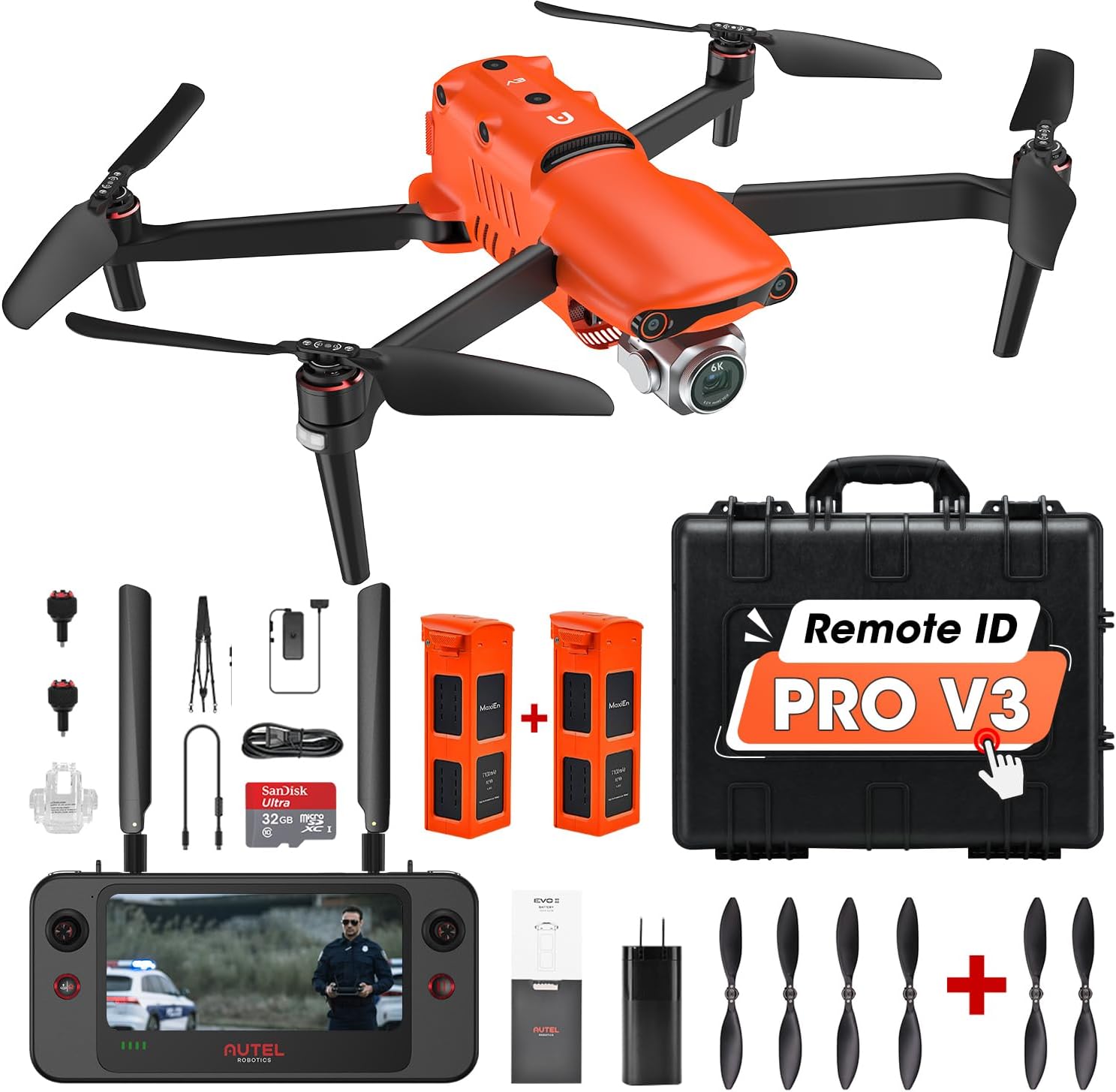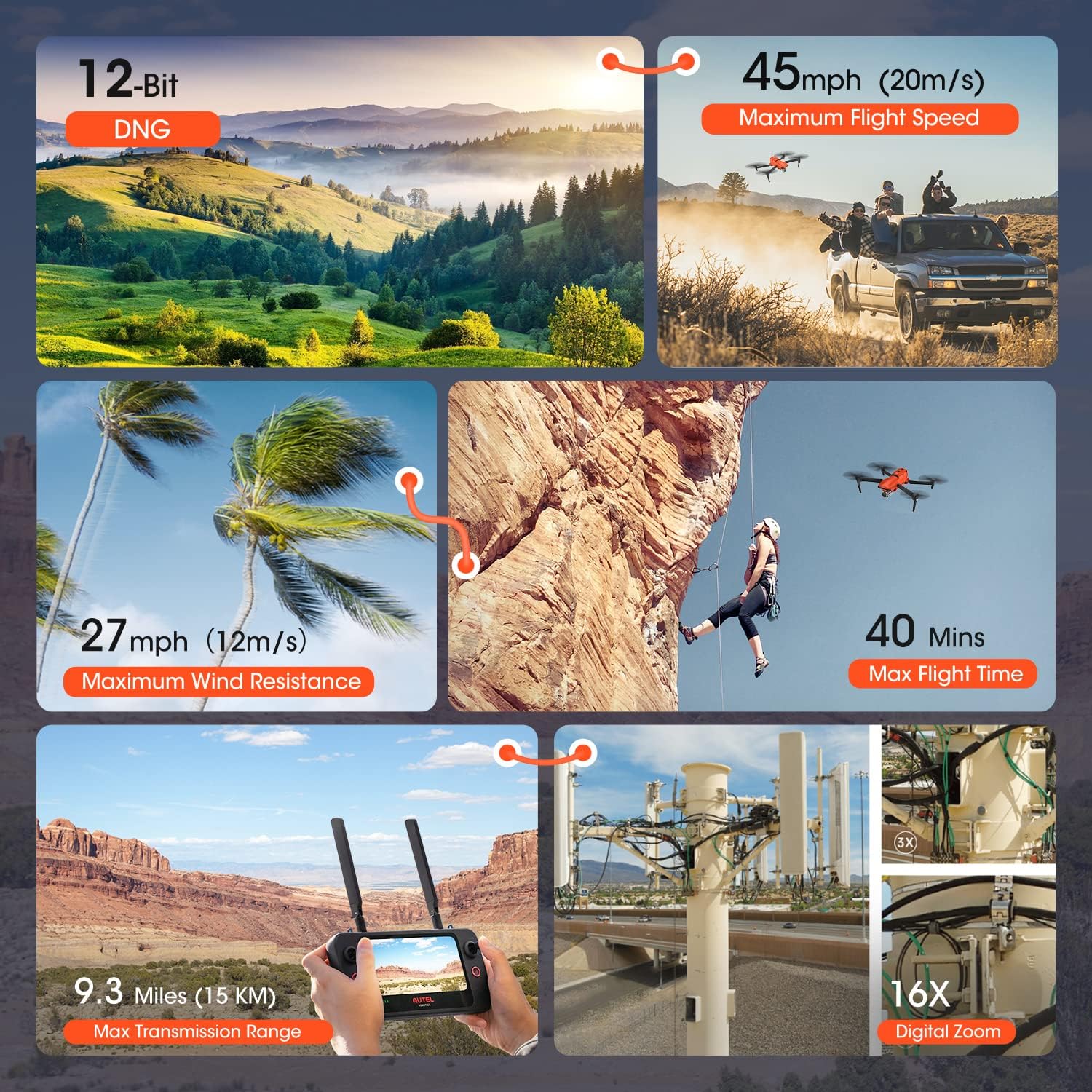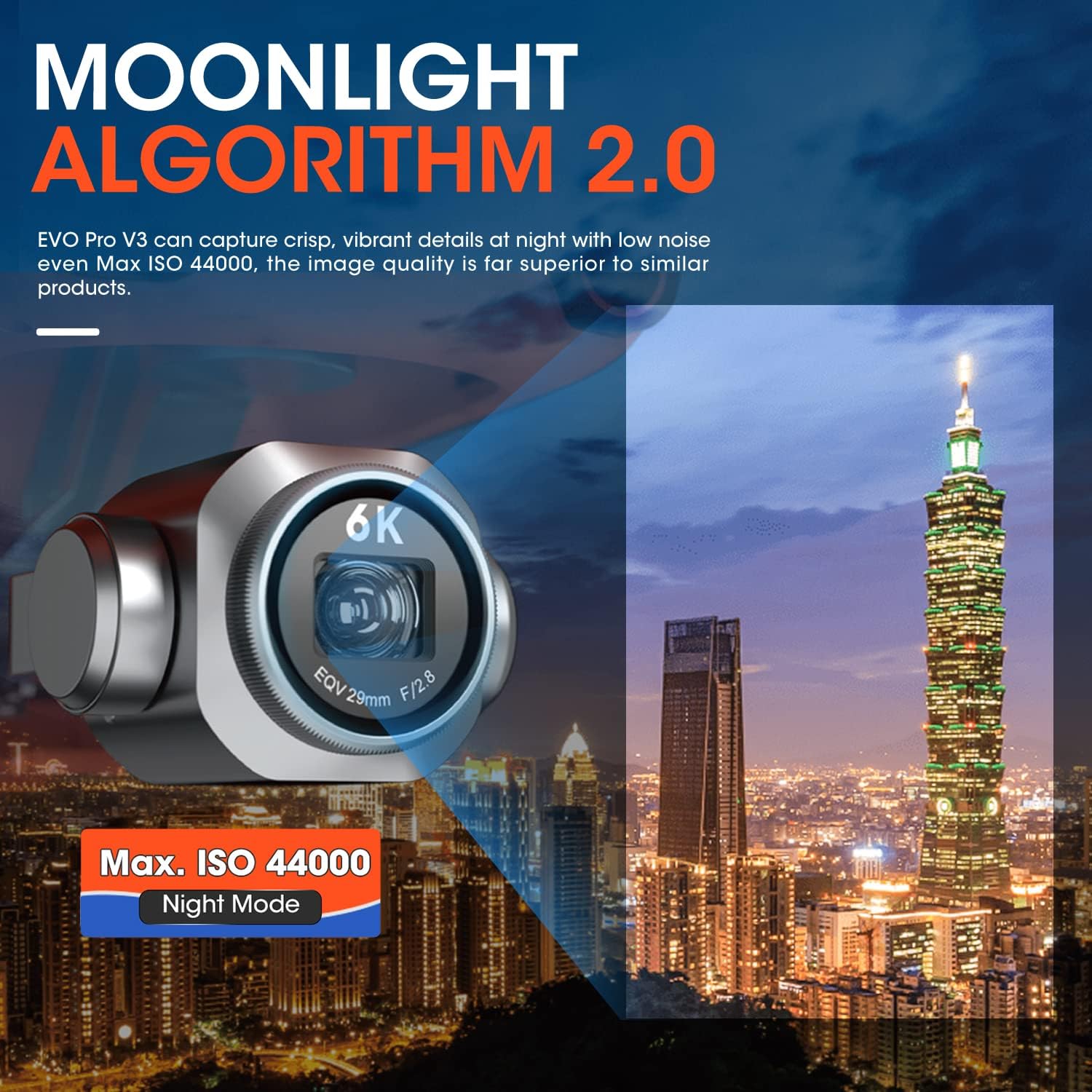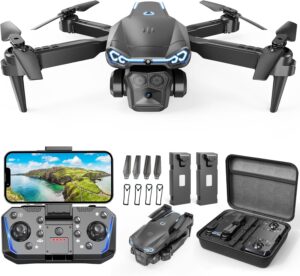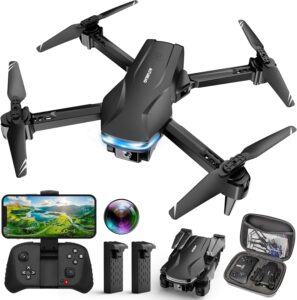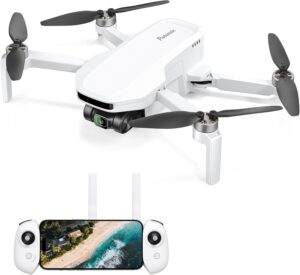Have we ever wanted a flying camera that actually keeps up with our ambitions, our creative whims, and our habit of overpacking for every shoot?
Why the Autel Robotics EVO 2 Pro V3 caught our attention
We weren’t exactly shopping for yet another drone, and yet the Autel Robotics EVO 2 Pro V3 kept turning up like a gorgeous orange stray cat that apparently knows our schedule better than we do. Between its 6K HDR video, a 1-inch Sony sensor, Moonlight Algorithm 2.0 for low-light, and a 15 km transmission system paired with a 6.4-inch Smart Controller SE, we started to wonder if this drone had secretly been attending our production meetings. Then we learned it avoids obstacles in 360 degrees, flies for up to 40 minutes, and ships without geo-fencing—and that’s when our curiosity turned into a purchase.
We’ll be honest: the dual after-sales guarantee didn’t hurt. Knowing the unit is 100% original, with both Autel Store support and a convenient U.S. warranty structure, made us feel less like daredevils and more like responsible adults. A rare feeling.
The product we tested
Autel Robotics EVO 2 Pro V3: Son-y 1″ CMOS Sensor & 6K HDR Video, Moonlight Algorithm 2.0, Max ISO 44000, 12-Bit DNG, 6.4″ Smart Controller SE, 15KM Transmission, 360° Obstacle Avoidance, 40 Minutes.
Yes, that’s a mouthful, but it reads like a CV we’re happy to hire.
Unboxing and first impressions
We’ll confess that unboxing is a ritual for us. The EVO 2 Pro V3 arrives with its bright, high-visibility orange fuselage, a hard plastic case that looks ready to survive a minor skirmish, and the excellent Smart Controller SE. The bundle we tested included two batteries, spare propellers, a gimbal holder, a 32 GB microSD card, and a few spares like control sticks. Everything felt properly engineered, without the air of disposable accessories we’ve seen elsewhere.
The drone itself feels robust—more “field tool” than “tech toy.” The arms fold neatly, the gimbal is well-protected, and the propellers go on without the kind of fiddly finger yoga that makes us say words we can’t print. It’s not the smallest or lightest drone in its class, but it feels like it could shoulder a small documentary without panic.
What’s in the box and what it means for us
We appreciated that this combo is flight-ready. With the Smart Controller SE included, we didn’t have to mess around with phone compatibility, cables, or dim screens under midday sun. The extra battery is the difference between a rushed shoot and a confident one. The hard case felt travel-worthy, and the 32 GB card got us started immediately, though we recommend 128 GB or 256 GB UHS-I cards if you’re shooting a lot of 6K or 12-bit DNG bursts.
A quick spec snapshot
Sometimes it helps to see the important bits lined up. Here’s a quick overview of the standout features we used most.
| Feature | What it is | Why we care |
|---|---|---|
| Sensor | 1-inch Sony CMOS, 20 MP | Big pixels, better low-light, serious dynamic range |
| Aperture | f/2.8–f/11 adjustable | Creative control, consistent exposures for video and mapping |
| Max Video | Up to 6K HDR | Sharper masters, room to crop, cinematic punch |
| Bit Depth | 12-bit DNG and A-Log | 68.6 billion colors, flexible grading |
| Transmission | Autel SkyLink 2.0, up to 15 km | Stable signal, strong anti-interference with tri-band hopping |
| Obstacle Avoidance | 360°, 12 vision sensors + 2 sonar + 2 LEDs | Safer flights, smarter navigation |
| Controller | Smart Controller SE, 6.4-inch OLED | Bright, legible screen; no phone needed; Android + 3rd-party apps |
| Flight Time | Up to 40 minutes (forward flight) | Less battery anxiety, more shots per launch |
| NFZ | No geo-fencing | Freedom to fly where it’s legal—our responsibility to check rules |
| Tracking | Dynamic Track 2.0 | Intelligent subject tracking that avoids obstacles |
| Safety | Failsafe RTH, bottom binocular landing | Accurate landings, automatic failsafes |
Design and build quality
We like machines that feel like machines—solid, thought through, and not fragile. The EVO 2 Pro V3 ticks those boxes. The airframe is rigid without being heavy-handed, the fold-out arms lock into place with confidence, and the landing gear feels stable. That bright orange livery is not just a fashion statement; it’s practical. We could spot the drone on return legs far more easily than a gray counterpart, and when it landed in tall brush (long story), we saw it right away.
The gimbal assembly is well-damped and doesn’t whisper “please be gentle” in the way some ultralight rigs do. We’ve tossed it in and out of a car trunk more times than we should, and it’s held up beautifully. It’s a drone built for work. The props are quick to install and secure under high RPMs, and Autel’s battery design includes a secure latch that resists ejection during aggressive maneuvers or rough landings. Not that we’re advocating for either.
The Smart Controller SE experience
The Smart Controller SE is the single best reason we didn’t hesitate to fly at odd hours or in unfamiliar places. The 6.4-inch OLED screen is bright, colorful, and legible in harsh daylight. The build quality inspires confidence—no creaks, no loose panels, no bargain-bin plastics. The layout makes sense: tactile sticks, programmable buttons, and a decent balance that doesn’t make our wrists protest during longer sessions.
And this is the part that sets the tone for the entire workflow: it runs a customized Android OS. Translation: we can load 3rd-party apps we trust, view maps offline, and troubleshoot without swapping to a phone. IP43 rating means it’s designed to handle the kinds of “maybe this drizzle will pass” moments we routinely face.
Setup and firmware sanity
We appreciated that the EVO 2 Pro V3 doesn’t lock us out for lack of a firmware update. If we’re in the field with a client and a storm is inbound, we’d prefer to fly, not negotiate with progress bars. Updates are there when we need them, but takeoff is not held hostage.
We still did our due diligence by calibrating the compass and IMU on first flight, setting our return-to-home altitude, and checking local regs. It’s our airspace, our responsibility.
Camera chops that match our ambition
Let’s be honest, most of us buy this aircraft for the camera. This one earns its “Pro” label.
The 1-inch Sony sensor and adjustable aperture
A 1-inch, 20-megapixel CMOS sensor on a drone still feels like magic to us. The Sony heritage shows in the tonality: skin retains nuance, skies hold detail, and foliage doesn’t melt into neon paste every time you look at it wrong. The adjustable aperture, from f/2.8 to f/11, gives us exactly the control we crave. In bright daylight, we can stop down without stacking NDs like a nervous magician; in lower light, we can open up and keep ISO modest.
A fixed-aperture drone is a compromise; this one is a camera that happens to fly.
6K HDR video with room to breathe
Shooting up to 6K gives us options. We might deliver in 4K or 1080p, but capturing in 6K lets us crop, stabilize, or punch in without turning our footage into watercolor. HDR options are there for high-contrast scenes when we want a cleaner roll-off and richer mid-tones. We noticed improved dynamic range and noise performance over previous versions, particularly in those challenging late-afternoon shots where the sky still wants to be a diva and the shadows are auditioning for experimental theater.
We were also impressed by the higher frame rate options at lower resolutions, which buy us smoother motion without sacrificing too much detail. For action-oriented work and quick handheld cutaways inside larger edits, it’s reassuring to have those choices.
12-bit DNG and A-Log for the color nerds among us
We’re the kind of people who can argue about LUTs the way some people argue about baseball. The EVO 2 Pro V3’s 12-bit color and A-Log profile are tailor-made for us. Autel claims a 68.6 billion color range, which reads like bragging until you’re pulling shadows up three stops and the image still has texture, not banding. The roll-off in highlights is graceful, and the mid-tone detail holds up under aggressive grading.
Shooting 12-bit DNG for stills gives us a wide latitude in post. We happily underexposed a hair to preserve bright clouds and recovered shadowed treelines without introducing a snowstorm of noise. The files take a little time to process, but so does coffee, and we still drink it every day.
Moonlight Algorithm 2.0 and max ISO 44,000
We don’t make a habit of night flying, but low light happens—sunsets run late, clients run later, and cityscapes beg for one more pass. Moonlight Algorithm 2.0 is Autel’s fancy way of saying “smarter noise reduction and detail retention in the dark.” Combined with the large sensor and that outrageous max ISO of 44,000, we were able to capture twilight shots with a creamy, cinematic noise pattern rather than a crunchy, digital mess.
Our advice is to avoid the top of the ISO range unless you absolutely must. The sweet spot for us was in the ISO 1600–6400 neighborhood for video, depending on the scene, and a bit higher for stills thanks to DNG’s flexibility. But if the mission truly calls for it, this drone can go further into the dark than we expected.
Real-world color and dynamic range
We talk a lot about specs, but the proof is in how footage looks. The EVO 2 Pro V3 renders color with a quiet confidence. Greens aren’t radioactive, reds don’t bleed, and blues keep their dignity. Dynamic range feels generous enough for landscape work with tricky clouds, reflective water, and deep shade. Is it a cinema camera on a two-pound gimbal? No. Is it astonishingly usable for high-end commercial drone work? Absolutely.
Flight performance and handling
A great camera on an anxious aircraft is not our idea of a good time. Fortunately, this is not that.
Stability and confidence in the air
In moderate wind, the EVO 2 Pro V3 is steady and predictable. It will drift a touch when a gust hits, but the gimbal does its part and the footage remains smooth. The stick response feels tuned for thoughtful cinematography rather than aggressive racing, though there’s plenty of speed when we need to reposition. We found it easy to creep along at inches-per-second for precise foreground parallax, which is always our litmus test for a drone designed to film, not just fly.
Noise levels are reasonable for its size. It’s not whisper-quiet, and little birds do not write thank-you notes, but it’s less audible at a distance than we anticipated.
40-minute flight time, honestly used
The 7,100 mAh battery and aerodynamic efficiency promise up to 40 minutes of flight time in forward movement and around 35 minutes when hovering. In the real world—accounting for wind, temperatures, and nerves—we comfortably got 28–33 minutes per pack while leaving a responsible buffer for return and landing.
That extra few minutes compared to smaller drones makes a difference. We had time for a second pass, a safety shot, and a few experimental moves we otherwise would have skipped. The included second battery effectively turns a quick mission into a meaningful session.
15 km transmission with tri-band resilience
The SkyLink 2.0 video transmission system feels mature. We flew in gnarly environments—downtown congestion, ridiculous Wi-Fi interference, and a coastal harbor riddled with metal and boats—and our video feed remained crisp. With automatic frequency hopping across 2.4 GHz, 5.8 GHz, and 900 MHz, the drone found healthy channels without us needing to babysit it.
We didn’t measure 15 km because we’re not trying to reenact a long-distance relationship. What matters is that within a mile or two, the signal was stable and confidence-inspiring.
360° obstacle avoidance that actually helps
Obstacle sensors can be overprotective nannies or indifferent bystanders. The EVO 2 Pro V3 lands closer to “helpful co-pilot.” With 12 computer vision sensors, two sonar sensors, and two LED landing lights, it sees the world in all directions. Bypassing obstacles felt smooth rather than panicky, and we didn’t get the maddening brake-checks that sometimes seem to happen for no reason on other drones.
Of course, we turned off some obstacle sensors when we wanted a very specific shot near tree branches. The key is consistency: when the system is on, it behaves predictably and buys us a layer of protection in unfamiliar spaces.
Dynamic Track 2.0 for subject tracking
We’re picky about tracking because poorly implemented systems turn talent walks into slapstick. Dynamic Track 2.0 was a pleasant surprise. It recognizes pedestrians in real time, follows them smoothly, and maintains composition while taking obstacle avoidance into account. We still keep a thumb on the stick and a brain in our head, but for real estate walk-throughs and follow shots in parks, it’s a useful assistant.
Failsafe return-to-home and accurate landings
We hope you never need it, and you will inevitably need it: failsafe RTH. When the connection breaks or the battery dips, the EVO 2 Pro V3 returns to its home point like a homing pigeon that knows where you hide the snacks. The bottom binocular vision camera builds depth maps to judge landing flatness and angle, which in practice meant fewer “who put this drone on a hill?” moments.
Set your RTH altitude carefully for your environment, and you’ll be impressed by the accuracy.
A note on geo-fencing and responsibility
We value freedom paired with responsibility. The EVO 2 Pro V3 does not include geo-fencing or built-in no-fly zone locks. That’s liberating if you work in places where approvals are legitimate, urgent, and often offline. But it means the burden is on us to know the rules, secure the necessary authorizations, and fly legally. We always check local regulations, obtain permissions when required, maintain VLOS, and avoid sensitive areas. The lack of a digital nanny is a trust we aim to earn.
Workflow: from launch to graded footage
A good drone accelerates our work, not just our heart rate.
Launching fast, capturing reliably
We unfolded, powered on, and took off in under two minutes on average. The Smart Controller’s screen clarity helped us nail white balance, exposure, and composition without squinting. We assigned custom buttons for histogram and overexposure warnings, which made it easy to shoot conservatively in high-contrast sunlight.
We typically shot A-Log for video and 12-bit DNG for stills, with a backup set of standard profiles for quick-turnaround jobs. The camera’s tone curve in A-Log is manageable, and Autel’s color science feels impressively neutral, letting our grading choices take the lead.
Grading and color management
Our grading workflow played nicely with the A-Log files. Skin tones stayed honest, skies didn’t band, and we could push cool/warm looks without the “plastic” sheen we’ve struggled with on lower-bit-depth cameras. If your project involves blending air and ground cameras, these files intercut better than we expected. For stills, the DNGs responded well to careful exposure correction and dehaze tools; the shadows lift cleanly, particularly when shot at conservative ISOs.
Using 3rd-party apps on the Smart Controller SE
We installed mapping support software and a few utility apps we trust. While we don’t recommend installing every shiny thing you find, the Android flexibility is a productivity boon. Offline maps and custom LUT previews felt like small luxuries that add up.
Mapping and professional capture
We don’t call this a specialty mapping drone, but it handles mapping tasks better than many “cinema-first” platforms.
Why 20 MP and adjustable aperture matter for mapping
For photogrammetry, consistent exposure across a grid is half the battle. With an adjustable aperture, we usually set a base ISO, lock shutter speed in a safe range, and ride the aperture for consistency. The 20 MP resolution delivers sharp tiles without inflating file sizes into the absurd. We got dependable results for small-to-medium sites, especially when wind was mild and overlap was generous.
We recommend shooting at mid-range apertures (f/4–f/5.6) for maximum sharpness and minimal diffraction, and using gentle sharpening in post rather than cranking in-camera settings.
Planning flights and maintaining accuracy
We used the Smart Controller for quick mapping missions (park paths, rooftops, small lots). For precise surveying that requires ground control points, we coordinate with local professionals and appropriate equipment. The EVO 2 Pro V3’s stability and predictable battery performance make it a safe choice for repeatable flights, and its lack of forced NFZ locks helps in permitted areas with patchy connectivity.
Where it stands in the market
We’d be remiss if we didn’t say the quiet part out loud: this drone exists in a world that includes DJI. Competition is a gift to us as buyers, and it shows.
EVO 2 Pro V3 vs. others we’ve flown
- Image quality: The 1-inch sensor, adjustable aperture, and 12-bit depth put the EVO 2 Pro V3 squarely into “serious tool” territory. It keeps pace with other top-tier drones in this sensor class. Low-light performance feels a touch stronger than many peers, thanks to Moonlight 2.0 and Autel’s tuning.
- Transmission: SkyLink 2.0’s tri-band hopping is robust in interference-heavy areas. We’ve had rock-solid feeds in places that gave other drones a headache.
- Controller: The Smart Controller SE’s OLED panel and Android flexibility are outstanding. Not needing a phone is a real quality-of-life improvement.
- Obstacle avoidance: It’s comprehensive and predictable. We’d trust it in complex environments more readily than basic forward-only systems.
- Geo-fencing: The freedom from geo-fencing makes legitimate, approved flights simpler. It also demands maturity and discipline from us as pilots.
The best use cases
We can babble about features all day, but here’s where this drone genuinely shines.
Creative and commercial video
If we need cinematic footage for real estate, documentary b-roll, travel pieces, or branded video, this drone is a go-to. It’s not the smallest, but it gives us a more “camera-first” look than many ultralights. It’s our choice when the image matters more than the backpack weight.
Low-light and twilight shoots
Cityscapes, maritime scenes, dusky landscapes—these are the EVO 2 Pro V3’s happy places. The combination of large sensor, adjustable aperture, and noise handling gives us that hour of usable light that a smaller-sensor drone usually can’t manage gracefully.
Mapping pilots and documentation projects
For quick site maps, small surveys, or construction progress documentation, this drone strikes a smart balance. It’s fast to deploy, consistent in capture, and friendly to workflows that need manageable file sizes and reliable battery endurance.
Public safety and search uses
We’ve seen teams value the lack of geo-fencing for authorized, time-sensitive operations. Good obstacle avoidance and strong signal penetration help in urban and wooded environments. Always fly within your jurisdiction’s rules and training protocols, of course.
Quirks, trade-offs, and the honest bits
We like it a lot, but nothing is perfect.
- Size and weight: It’s not a featherweight. If you’re hiking miles into a location or trying to be as discreet as possible, you might pack a smaller drone as well. But we’ll happily carry the extra few ounces for the image quality.
- Prop noise: Physics is physics. It’s not obnoxious, but be mindful of noise-sensitive locations.
- Color tuning: Autel’s A-Log is neutral and flexible, but if you’re used to a very specific look out of the box from another brand, plan on crafting a fresh grade or LUT for this system. The good news is, this drone’s files reward that effort.
- Storage planning: 6K and 12-bit DNG eat space for breakfast. Bring larger microSD cards and a fast, redundant backup workflow.
- App ecosystem: The Smart Controller’s Android flexibility is great, but you’ll want to be deliberate about which 3rd-party apps you trust and keep everything updated.
Tips for the best results
We learned a few things that made a difference.
- Use ND filters: For daytime video, a variable ND or a set of fixed NDs helps keep shutter speeds in cinematic ranges without compromising ISO.
- Mid-range aperture: For maximum sharpness, f/4 to f/5.6 is our sweet spot. Avoid f/11 unless you’re stuck in extreme brightness and don’t have an ND handy.
- Conservative ISO: Let the big sensor do its job. Keep ISO modest when possible; save the high-ISO heroics for when they truly matter.
- Calibrate early: Compass/IMU calibrations on first flight, and whenever you travel significant distances. It saves headaches later.
- Custom buttons: Put histogram, overexposure zebra, RTH, and gimbal re-center on buttons you can hit without looking.
- RTH altitude: Set a safe altitude for your environment before every mission. It’s five seconds that can save you a world of regret.
- Preflight checklist: Props on, battery latched, gimbal clamp off, SD card inserted, home point updated, weather checked, airspace verified. We say it out loud because memory is a prankster.
- Dual-record if possible: If your workflow allows, record proxies or lower-res backups on a second device for fast review while keeping your 6K masters pristine.
Battery life, charging, and logistics
We appreciate that Autel’s batteries lock securely and report health reliably. Charging is straightforward, and we adopted a rotation: active, warm spare, and a third cooling after landing. We avoid charging batteries hot from flight, and we store them at around 50% when idle for more than a week. Battery ejection resistance during hard landings is not a feature we intended to test, and yet we are human. It works.
We also recommend keeping a small log of cycles and a periodic deep balance charge if your charger supports it. Treat batteries kindly, and they treat you back.
Obstacle avoidance in the real world
We did not try to trick the sensors with black velvet labyrinths, but we flew through trees, near lamp posts, and along building façades. The system warned early, braked smoothly, and navigated around hazards with a degree of grace that made us forgive the occasional conservative pause. The LED landing lights turned dusk landings into neatly executed descents rather than guesswork.
We still prefer line-of-sight and a spotter in busy areas. Technology helps; awareness saves.
Reliability, warranty, and support
Knowing the unit is 100% original and backed by both Autel Store after-sales and a U.S.-based warranty gave us peace of mind. In a world where shipping a tool overseas for a repair can pause a project, having local support matters. We didn’t need service during our testing, but prior experiences with Autel’s support have been respectful and solution-oriented. The combo’s 30-day replacement or full refund policy and a 12-month defects coverage period are practical, not just marketing.
We always recommend registering your aircraft, labeling batteries, and keeping receipts and serials organized. It makes warranty conversations painless, which is the only acceptable flavor of warranty conversation.
Safety, training, and legal considerations
A few reminders we live by:
- Know your airspace: Check local and national regulations before each flight. Geo-fence freedom is not a license to ignore rules.
- Maintain VLOS: Keep the aircraft in visual line-of-sight. Your signal can reach far beyond where your eyes can.
- Weather is not your friend: Wind gusts, precipitation, and temperature extremes become much more persuasive once you’re airborne.
- Preflight and postflight: Structured checklists keep you honest. We perform a quick airframe and prop inspection every time. It’s the dental floss of flying—no one loves doing it, but everyone loves the outcome.
- Permissions matter: Get property and airspace permissions for commercial work. Document them. Future you will be grateful.
The little delights we didn’t expect
- The orange shell: It’s easy to see against blue skies and green fields. We didn’t know we needed this. Turns out we did.
- The OLED screen at noon: Seeing exposure and focus in full sun without draping ourselves in a jacket is a small miracle.
- Bottom binocular landing: Watching the drone hover and “think” for a moment, then choose a flatter patch to land on, felt strangely human—like it has standards.
- Moonlight is not hype: The footage at civil twilight has a calm, filmic quality that we genuinely enjoyed grading.
Potential wish list for the next version
We’re happy now, but we can still dream.
- Slightly quieter props: Any incremental noise reduction is a gift in sensitive environments.
- More granular noise reduction control: Let us tune NR at a deeper level for low-light video.
- In-app LUT support: The ability to preview LUTs on the Smart Controller would speed creative decisions.
Who will love this drone
- Filmmakers and content creators who prioritize image quality and flexible grading.
- Real estate and commercial shooters who need dependable results with minimal setup.
- Mapping and inspection professionals who benefit from a 1-inch sensor and adjustable aperture.
- Public safety teams with authorization to fly where and when they must, appreciating the lack of geo-fencing.
- Anyone who wants a professional rig with a controller that doesn’t require a phone dance.
Who might prefer something else
- Backpackers and ultralight minimalists who count ounces more than pixels.
- Pilots who rely on fully integrated NFZ databases as a guardrail for operations.
- Casual flyers who prefer “just-press-go” simplicity over manual exposure control and post-production flexibility.
Our real-world settings cheat sheet
We keep a mental set of go-to settings that save time:
- Golden hour video: A-Log, 6K, 1/50–1/60 shutter for 24/30p, f/4–f/5.6, ISO 200–400, ND as needed.
- Midday landscapes: A-Log, 6K, 1/50–1/60 shutter, f/5.6–f/8 with ND 4–16, ISO 100–200.
- Low-light cityscapes: A-Log, 4K, 1/50–1/60 shutter, f/2.8–f/4, ISO 800–3200, apply gentle NR in post.
- Stills: 12-bit DNG, auto-bracket (AEB) for high-contrast scenes, f/4–f/5.6, ISO 100–400.
Adjust to taste, but this baseline gave us consistent results.
The bottom line we keep coming back to
We judge gear by how often we reach for it. The Autel Robotics EVO 2 Pro V3 has been our default choice whenever quality matters and time is short. It’s quick to deploy, generous in the air, and trustworthy when obstacles, interference, or shifting light would make lesser drones sulk.
The camera delivers honest, flexible files—6K HDR video and 12-bit DNG stills that we can bend without breaking. The 1-inch Sony sensor combined with an adjustable aperture is the practical, grown-up pairing we want in a professional aerial camera. The Moonlight Algorithm 2.0 and high ISO ceiling mean we don’t pack up just because the sun did. The Smart Controller SE feels like it was built by people who’ve actually tried to fly at noon and at midnight, and didn’t want to make excuses to the client.
We love the 360° obstacle avoidance that acts like a co-worker who taps our shoulder politely rather than yanking the controller out of our hands. We value the rock-solid transmission and sensible failsafes. We respect the lack of geo-fencing and fly accordingly.
Is it perfect? Of course not. It’s a bit bigger than the travel-cute options, and it expects that we’ll bring our A-game in post. But if our goal is to come home with footage that looks like we meant it—and we almost always mean it—this drone makes that outcome feel routine.
In a crowded field, the EVO 2 Pro V3 earns its place by doing the unglamorous work well: starting quickly, flying confidently, and handing us beautiful files that grade like a dream. We bought it for the camera and kept it for the way it fits our life on set and in the field.
If we had to sum up our experience in one sentence, it would be this: the Autel Robotics EVO 2 Pro V3 is the rare flying camera that treats our time, our plans, and our footage with equal respect—and that’s why it keeps coming with us.
Disclosure: As an Amazon Associate, I earn from qualifying purchases.
